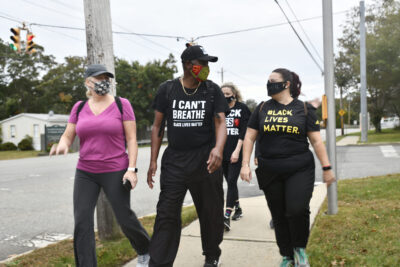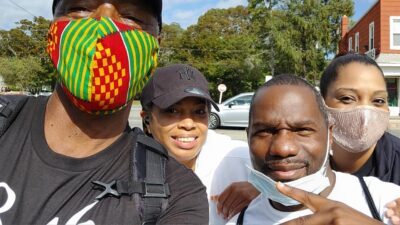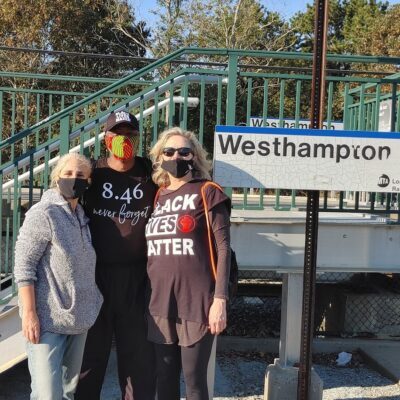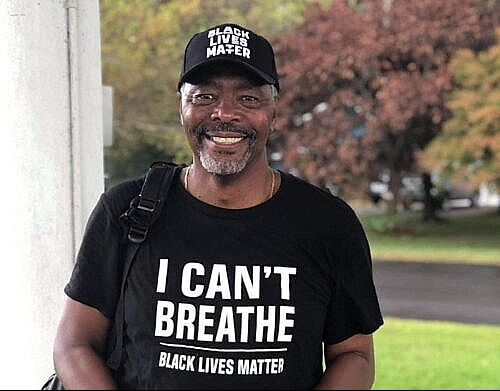Leon Goodman, 69, is an unabashed ally and staunch supporter of the Black Lives Matter Movement which has done more than any other organization to expose and challenge the racist system of policing on these shores. Rather than join the surge of large-scale, anti-police brutality protests of recent times, Leon decided to address the injustices by spanning the entire length of Long Island, New York, 118 miles, by walking in silent protest.
Leon is an entertainment writer with 50BOLD, retired human resources executive, and part-time actor. He began his walk on October 1 at the foot of the 59th Street Bridge in Manhattan and ended his protest 17 days later at the Montauk Point Light at the easternmost point of Long Island in the hamlet of Montauk, New York. Leon clocked in an average of 10 to 15 miles daily with periodic days off. He would begin his trek on the island’s commuter rail system, the Long Island Rail Road (LIRR), travel to the stop where he ended the night before, then walk his arduous journey to his next stop, before heading back on the train.

Not everyone who is angered by a broken justice system will resort to violence. Leon abhors violent retaliation and feels that anti-police violence is carried out by fringe extremists who certainly do not represent the broader movement. “Police killings have become a pandemic of sorts and the senseless and mindless brutality towards our people has got to end but silent protest can also be a powerful strategy. Silence is speech! I am prayerful that my silent protest serves to bring the systemic racism involving law enforcement into unavoidable light.”
The Bay Shore, Long Island resident is no stranger to police profiling having been a victim of it a few years back. The year was 2006, Leon was the only Black commuter to exit the LIRR amongst a crowd of all white passengers. Little did Leon know at the time, he was being observed. As the then human resources executive exited the parking lot, he was suddenly pulled over by a white policeman who demanded to see his ID. When Leon respectfully questioned the officer as to why he was singled out, the policeman resorted to humiliating him via verbal abuse and detainment for no reason. Leon was left feeling violated, angry, and wary of police and their motives.
Black people are killed at a rate higher than their proportion to the national population. Racial disparity is even more pronounced in those cases in which the victims were unarmed and offered minimal to no threat to police. Leon cites some alarming Justice Department statistics. “Black people are up to 3.5 times more likely than whites to be killed by law enforcement; one in every 1,000 Black men will die at the hands of police,” he said. “I am scared for my children. I am scared for my grandchildren. I am scared for my great grandchildren. I am scared for myself.”

In preparation for his journey, Leon contacted his local law enforcement department to ensure he wasn’t breaking any laws. He also practiced walking daily distances of up to 6.5 miles over a period three to four days in a row. Although not an avid walker in general, Leon’s undertaking fueled him. He stepped outside of his comfort zone and actually took a stand against the horrendous ways Black people are often treated by the men in blue.
According to the impassioned father of three, he wanted to join the public outcry because the police’s excessive use of force seemingly has no excuse. “I am silently protesting and walking for Eric Garner, Michael Brown, Tamir Rice, Walter Scott, Alton Sterling, Trayvon Martin, Philando Castile, Stephon Clark, Sandra Bland, Ahmaud Arbery, Breonna Taylor, and George Floyd, amongst others. Are you listening? Do you hear us?”
Historians said protesting silently proved to be an effective tactic of the civil rights movement, and also in protests against the Vietnam War. So Leon, who grew up in Virginia during segregation has high hopes that his protest was not in vain. During his walk, he managed to meet supporters who were sympathetic to his cause, many of whom were white.

Leon also stumbled across a few folks who were not so welcoming. Walking through the predominantly white town of Seaford in his “Black Lives Matter” T-shirt and hat uniform, a white female motorist yelled out to him, “Blue Lives Matter!” Even though Leon was taken aback at first by the woman’s zealous remark, he was more than willing to dialogue with the mom about his position. But before he could approach the woman in the minivan who had stopped at a light with her children in tow; she sped off.
Leon also met up with BLM organizers like Lisa Votino and Willie Jenkins who accompanied him during certain points along the way. According to Leon, “they provided me with such insightful information about the movement and were so encouraging as well.”
Since the goal of a protest is to create a political moment that decision-makers — the people in power — just can’t ignore. Leon thought his way of protesting was a respectful affirmation of Black humanity. “Standing on the sidelines equals complicity and history has taught us that two conditions are necessary for change. People must stand up for their rights and people in power must respond. I am hopeful that a change is gonna come. We must all continue to stand with the families of those who were brutally murdered at the hands of law enforcement officers who had total disregard for their lives.”
For more information on the Black Lives Matter movement visit: https://blacklivesmatter.com/











